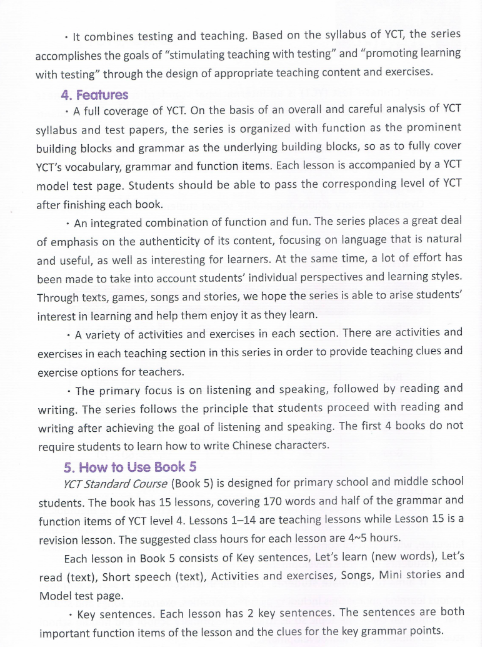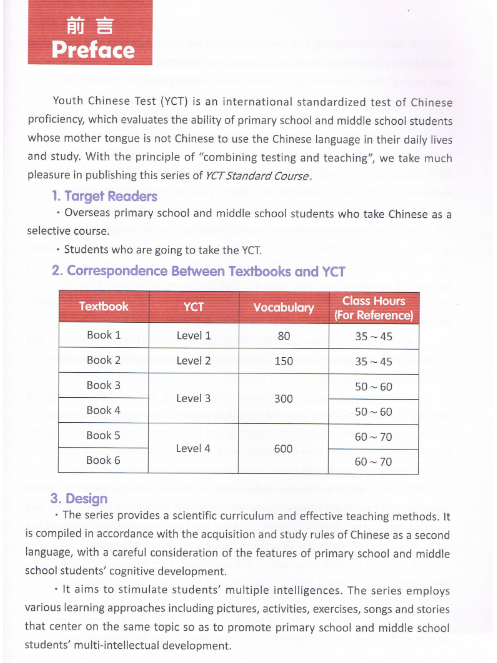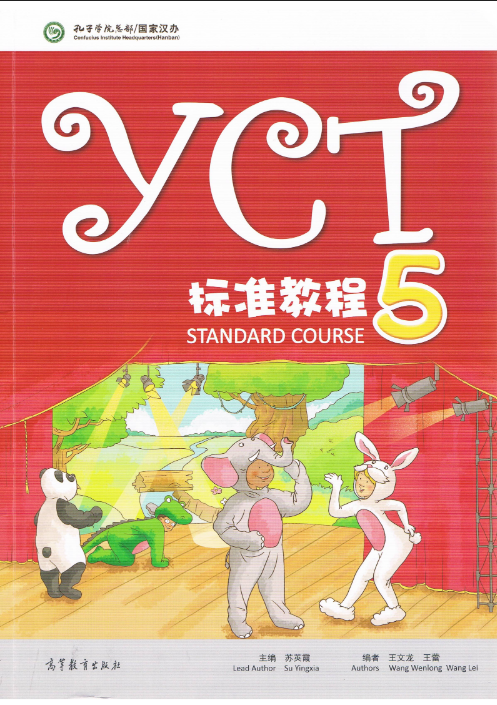


前言
Preface
Youth Chinese Test (YCT) is an international standardized test of Chinese proficiency, which evaluates the ability of primary school and middle school students whose mother tongue is not Chinese to use the Chinese language in their daily lives and study. With the principle of “combining testing and teaching”, we take much pleasure in publishing this series of YCT Standard Course.
- Target Readers
- Overseas primary school and middle school students who take Chinese as a selective course.
- Students who are going to take the YCT.
- Correspondence Between Textbooks and YCT
| Textbook | YCT | Vocabulary | Class Hours (For Reference) |
| Book 1 | Level 1 | 80 | 35 ~ 45 |
| Book 2 | Level 2 | 150 | 35 ~ 45 |
| Book 3 | Level 3 | 300 | 50 ~ 60 |
| Book 4 | Level 3 | 300 | 50 ~ 60 |
| Book 5 | Level 4 | 600 | 60 ~ 70 |
| Book 6 | Level 4 | 600 | 60 ~ 70 |
- Design
- The series provides a scientific curriculum and effective teaching methods. It is compiled in accordance with the acquisition and study rules of Chinese as a second language, with a careful consideration of the features of primary school and middle school students’ cognitive development.
- It aims to stimulate students’ multiple intelligences. The series employs various learning approaches including pictures, activities, exercises, songs and stories that center on the same topic so as to promote primary school and middle school students’ multi-intellectual development.
- It combines testing and teaching. Based on the syllabus of YCT, the series accomplishes the goals of “stimulating teaching with testing” and “promoting learning with testing” through the design of appropriate teaching content and exercises.
- Features
- A full coverage of YCT. On the basis of an overall and careful analysis of YCT syllabus and test papers, the series is organized with function as the prominent building blocks and grammar as the underlying building blocks, so as to fully cover YCT’s vocabulary, grammar and function items. Each lesson is accompanied by a YCT model test page. Students should be able to pass the corresponding level of YCT after finishing each book.
- An integrated combination of function and fun. The series places a great deal of emphasis on the authenticity of its content, focusing on language that is natural and useful, as well as interesting for learners. At the same time, a lot of effort has been made to take into account students’ individual perspectives and learning styles. Through texts, games, songs and stories, we hope the series is able to arise students’ interest in learning and help them enjoy it as they learn.
- A variety of activities and exercises in each section. There are activities and exercises in each teaching section in this series in order to provide teaching clues and exercise options for teachers.
- The primary focus is on listening and speaking, followed by reading and writing. The series follows the principle that students proceed with reading and writing after achieving the goal of listening and speaking. The first 4 books do not require students to learn how to write Chinese characters.
- How to Use Book 5
YCT Standard Course (Book 5) is designed for primary school and middle school students. The book has 15 lessons, covering 170 words and half of the grammar and function items of YCT level 4. Lessons 1–14 are teaching lessons while Lesson 15 is a revision lesson. The suggested class hours for each lesson are 4~5 hours.
Each lesson in Book 5 consists of Key sentences, Let’s learn (new words), Let’s read (text), Short speech (text), Activities and exercises, Songs, Mini stories and Model test page.- Key sentences. Each lesson has 2 key sentences. The sentences are both important function items of the lesson and the clues for the key grammar points.
- Let’s learn (new words). Each lesson has about 12 new words, with no more than 3 words that are not included in the syllabus (all marked with *). Most nouns appear in the form of pictures and are followed with Chinese characters, Pinyin and English translation. The other words are followed with Chinese characters, Pinyin, English translation and collocations or sample sentences.
- Let’s read and Short speech (texts). Each lesson has 2 texts. “Let’s read” is a conversation, while “Short speech” is a passage. Questions after the texts help teachers evaluate if students have fully understood the texts.
- Activities and exercises. The book has both traditional exercises such as filling in the blanks and matching, and interactive activities or games. The alternative activities and exercises help the class achieve a balance between being dynamic and static.
- Songs. Some lessons contain a song related to the topic. Students can sing and dance at the same time, which helps to develop their multiple intelligences through a variety of stimuli.
- Mini stories. Some lessons provide an interesting mini story related to the topic. Students can act it out in groups after reading it.
- Model test page. Each lesson has a YCT model test page attached, which helps students familiarize themselves with the test and pass YCT successfully after finishing the book.
The Confucius Institute Headquarters, China Higher Education Press and Chinese Testing International (CTI) have offered tremendous support and guidance during the planning and compiling of the series. Domestic and foreign experts in related fields have also given us many valuable comments and suggestions. It is our sincere wish that the YCT Standard Course will open the door to Chinese learning for overseas primary school and middle school students, and help them learn and grow happily and healthily.
Authors
August, 2016
目 录
Contents
热 身 Warm-up 1
Lesson 1 你对中国功夫感兴趣吗?
Are you interested in Chinese kung fu? 3
Lesson 2 兔子更可爱。 Rabbits are even cuter. 11
Lesson 3 电梯坏了。 There is something wrong with the elevator. 19
Lesson 4 每个人都有自己的习惯。 Everyone has their own habits. 27
Lesson 5 他们多
年轻‾\underline{\text{年轻}}年轻
啊! They’re so young! 35
Lesson 6 站着的是坐着 的? The one standing or the one sitting? 43
Lesson 7 我经常去体育馆锻炼身体。 I often go to the gym to work out. 51
Lesson 8 北京一共有四个季节。 Beijing has four seasons altogether. 59
Lesson 9 冰淇淋既好吃又便宜。 The ice cream is delicious and cheap. 67
Lesson 10 你的汉语会越来越好。 Your Chinese will get better and better. 75
Lesson 11 来一
盘羊肉饺子‾\underline{\text{盘羊肉饺子}}盘羊肉饺子
。 I’d like a plate of lamb dumplings. 83
Lesson 12 飞机或者坐
火车‾\underline{\text{火车}}火车
都可以。
You can either take the plane or the train. 91
Lesson 13 我先帮
你补牙‾\underline{\text{你补牙}}你补牙
。 I’ll do the filling for you first. 99
Lesson 14 我
打算‾\underline{\text{打算}}打算
去中国旅行。 I’m planning to go travelling in China. 107
Lesson 15 复习 Review 115
词语表 Vocabulary 118
课文和小故事翻译 Text and Mini Story Translation 123
听力文本 Listening Scripts 127
测试页答案 Test Answers 131
YCT奖状 YCT Award 135
热 身
Warm-up
Let’s review the words
[Audio icon] 00-01
Listen to the recording twice, and number the pictures 1-12.
[Image of a fish] [Image of two bowls] [Image of a school building with a fence] [Image of an umbrella]
[Image of a student sleeping at a desk] [Image of a boy with colorful ribbons] [Image of a clock] [Image of a girl with a backpack]
[Image of a person relaxing on a lounge chair] [Image of a blackboard with Chinese characters] [Image of the number 1080] [Image of two pencils]
Let’s ask and answer
Nǐ Hànyǔ duōcháng shíjiān le?
你汉语多长时间了?
How long have you been learning Chinese?
Nǐ juéde Hànyǔ nán bù nán?
你觉得汉语难不难?
Do you think Chinese is difficult or not?
Wǒ wèi shénme xué Hànyǔ?
我为什么学汉语?
Why do you study Chinese?
Nǐmen xuéxiào yǒu duōshao rèn xuéxí Hànyǔ?
你们学校有多少人学习汉语?
How many students in your school learn Chinese?
Nǐ qùguò Zhōngguó ma? (Nǐ shì shénme shíhòu qù de? Nǐ shì zěnme qù de?)
你去过中国吗? (你是什么时候去的? 你是怎么去的?)
Have you been to China? (When did you go? How did you go?)
Pair work. Answer the questions with your partner. Then organize the answers and introduce your partner to the class.


